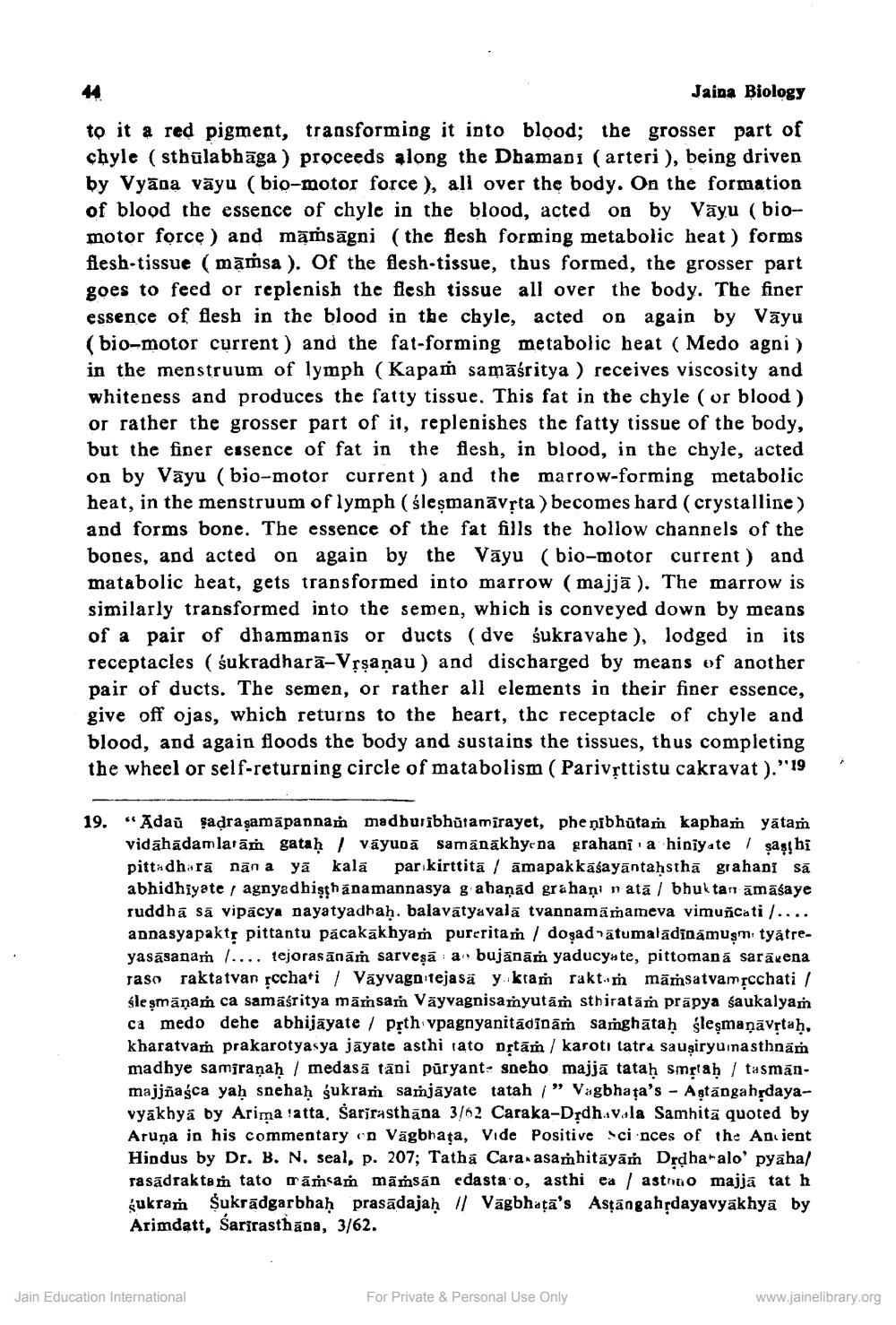________________
Jaina Biology
to it a red pigment, transforming it into blood; the grosser part of chyle (sthūlabhāga ) proceeds along the Dhamadı (arteri ), being driven by Vyāna vāyu (bio-motor force ), all over the body. On the formation of blood the essence of chyle in the blood, acted on by Vāyu (biomotor force ) and māṁsāgni (the flesh forming metabolic heat ) forms flesh-tissue (maṁsa ). Of the flesh-tissue, thus formed, the grosser part goes to feed or replenish the flesh tissue all over the body. The finer essence of flesh in the blood in the chyle, acted on again by Vāyu (bio-motor current) and the fat-forming metabolic heat (Medo agni) in the menstruum of lymph (Kapam samāśritya ) receives viscosity and whiteness and produces the fatty tissue. This fat in the chyle (or blood ) or rather the grosser part of it, replenishes the fatty tissue of the body, but the finer essence of fat in the flesh, in blood, in the chyle, acted on by Vāyu (bio-motor current) and the marrow-forming metabolic heat, in the menstruum of lymph (śleşmanāvsta ) becomes hard (crystalline) and forms bone. The essence of the fat fills the hollow channels of the bones, and acted on again by the Vāyu (bio-motor current) and matabolic heat, gets transformed into marrow (majjā). The marrow is similarly transformed into the semen, which is conveyed down by means of a pair of dhammanis or ducts (dve sukravahe), lodged in its receptacles ( sukradhara-Vrsanau ) and discharged by means of another pair of ducts. The semen, or rather all elements in their finer essence, give off ojas, which returns to the heart, the receptacle of chyle and blood, and again floods the body and sustains the tissues, thus completing the wheel or self-returning circle of matabolism (Parivșttistu cakravat)."19
19. "Adau gadra samāpannam madhuribhūtamirayet, phe nibhūtam kapham yatam
vidāhādamlatām gataḥ | váyudā samānākhyena grahani a hiniyate / sans hi pittadh rā nān a ya kalā par kirttita / āmapakkāśayāntahsthā grahani Să abhidhiyate , agnyadhisthānamannasya g ahaņād grahaņi natā / bhuktan āmāśaye ruddha sa vipācya nayatyadhaḥ. balavatyavalā tvannamārameva vimuñcati/.... annasyapaktr pittantu pacakakhyaṁ pureritam / dogadrātumaladinámugm. tyátreyasasanam .... tejorasānām sarveşā as bujānām yaducyate, pittomana sarāvena raso raktatvan rcchati / Vayvagn tejasā y kram rakt māṁsatvam rcchati / sleşmānam ca samasritya māmsam Väyvagnisamyutām sthiratām prāpya saukalyam ca medo dehe abhijāyate / Prth vpagnyanitādinām samghātaḥ śleşmaņāvstah, kharatvan prakarotyasya jāyate asthi rato Dștām / karoti tatra sauşiryuinasthnām madhye samjraṇaḥ / medasā tāni püryant- sneho majjā tataḥ smrah / tasmanmajjñaśca yaḥ snehaḥ śukran samjāyate tatah " Vagbhasa's - Aştāngah dayavyakhya by Arima atta. Sarirasthāna 3/62 Caraka-Drdh.vola Samhita quoted by Aruņa in his commentary co Vágbhaga, Vide Positive ci'nces of the Ani jent Hindus by Dr. B. N. seal, p. 207; Tatha Cara asamhitāyāṁ Drdha-alo' pyaha/ rasādraktam tato rāmsam māmsan edasta o, asthi ea / asthto majja tat h sukran Sukrādgarbhaḥ prasādajaḥ 11 Vägbhata's Astāngahşdayavyākhyā by Arimdatt, Sarrasthāna, 3/62.
Jain Education International
For Private & Personal Use Only
www.jainelibrary.org




